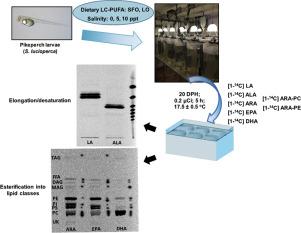当前位置:
X-MOL 学术
›
Comp. Biochem. Physiol. B Biochem. Mol. Biol.
›
论文详情
Our official English website, www.x-mol.net, welcomes your
feedback! (Note: you will need to create a separate account there.)
Esterification and modification of [1-14C] n-3 and n-6 polyunsaturated fatty acids in pikeperch (Sander lucioperca) larvae reared under linoleic or α-linolenic acid-based diets and variable environmental salinities.
Comparative Biochemistry and Physiology B: Biochemistry & Molecular Biology ( IF 1.9 ) Pub Date : 2020-05-11 , DOI: 10.1016/j.cbpb.2020.110449 D B Reis 1 , J A Pérez 1 , I Lund 2 , N G Acosta 1 , B Abdul-Jalbar 3 , A Bolaños 1 , C Rodríguez 1
Comparative Biochemistry and Physiology B: Biochemistry & Molecular Biology ( IF 1.9 ) Pub Date : 2020-05-11 , DOI: 10.1016/j.cbpb.2020.110449 D B Reis 1 , J A Pérez 1 , I Lund 2 , N G Acosta 1 , B Abdul-Jalbar 3 , A Bolaños 1 , C Rodríguez 1
Affiliation

|
To elucidate the in vivo endogenous ability of pikeperch (Sander lucioperca) larvae to deacylate and reacylate phospholipids and to elongate and desaturate PUFAs, 20 days post hatch (DPH) fish were incubated with either [1-14C]20:4n-6 bound to PC and PE, or with free [1-14C]-labelled fatty acids (18:2n-6, 18:3n-3, 20:4n-6, 20:5n-3 and 22:6n-3). The modulation capacity of both low LC-PUFAs but high 18C PUFAs precursors dietary supply and increasing salinity on larval fatty acid metabolic pathways was also investigated. [1-14C]DHA was incorporated into larval tissues to a lower extent than [1-14C]ARA or [1-14C] EPA. [1-14C]ARA was significantly less abundant in larval tissues when provided bound to PE than when esterified into PC, indicating that PC is a better phospholipid source to provide LC-PUFA to pikeperch larvae. Radioactivity was mainly recovered into phospholipids, especially that of the three LC-PUFAs ARA, EPA and DHA. All substrates were primarily incorporated into PC except [1-14C]ARA which significantly did into PI. Both [1-14C]EPA and [1-14C]DHA showed a similar esterification pattern into lipid classes: PC > PE > PI > TAG, with [1-14C]DHA presenting the highest esterification into PE of all radiolabelled compounds (26.3% vs 3.6-14.2%). Although higher rearing salinities tended to increase ∆6 desaturase activity, no radioactivity from [1-14C]18:2n-6 or [1-14C]18:3n-3 was detected in ARA or EPA, proving a deficiency of Δ5 activity and the inability of pikeperch to biosynthesize DHA. This work provides novel information on the lipid metabolism of pikeperch at early development necessary for the design of live prey enrichment protocols and dietary formulations adapted to larval metabolic capabilities.
中文翻译:

在亚油酸或以α-亚麻酸为基础的日粮和可变盐度下饲养的鲈鱼幼体中[1-14C] n-3和n-6多不饱和脂肪酸的酯化和修饰。
为了阐明鲈鱼(Sander lucioperca)幼虫在体内使磷脂去酰化和再酰化以及延长和去饱和PUFA的内源能力,在孵化(DPH)后20天,将鱼与[1-14C] 20:4n-6结合PC和PE,或含有游离的[1-14C]标记的脂肪酸(18:2n-6、18:3n-3、20:4n-6、20:5n-3和22:6n-3)。还研究了低LC-PUFAs和高18C PUFAs前体的日粮供应以及幼虫脂肪酸代谢途径中盐度增加的调节能力。[1-14C] DHA掺入幼虫组织的程度要低于[1-14C] ARA或[1-14C] EPA。[1-14C]与PE结合时,与PE结合时,在幼虫组织中的ARA含量明显少于酯化为PC时,表明PC是提供更好的磷脂来源,可为鲈鱼幼虫提供LC-PUFA。放射性主要被回收为磷脂,尤其是三种LC-PUFA ARA,EPA和DHA的磷脂。除[1-14C] ARA显着掺入PI外,所有底物均主要掺入PC中。[1-14C] EPA和[1-14C] DHA在脂类中均显示出相似的酯化模式:PC> PE> PI> TAG,其中[1-14C] DHA在所有放射性标记化合物中对PE的酯化程度最高(26.3 %vs 3.6-14.2%)。尽管较高的饲养盐度倾向于增加Δ6去饱和酶的活性,但在ARA或EPA中未检测到[1-14C] 18:2n-6或[1-14C] 18:3n-3的放射性,证明Δ5活性和鲈鱼无法生物合成DHA。
更新日期:2020-05-11
中文翻译:

在亚油酸或以α-亚麻酸为基础的日粮和可变盐度下饲养的鲈鱼幼体中[1-14C] n-3和n-6多不饱和脂肪酸的酯化和修饰。
为了阐明鲈鱼(Sander lucioperca)幼虫在体内使磷脂去酰化和再酰化以及延长和去饱和PUFA的内源能力,在孵化(DPH)后20天,将鱼与[1-14C] 20:4n-6结合PC和PE,或含有游离的[1-14C]标记的脂肪酸(18:2n-6、18:3n-3、20:4n-6、20:5n-3和22:6n-3)。还研究了低LC-PUFAs和高18C PUFAs前体的日粮供应以及幼虫脂肪酸代谢途径中盐度增加的调节能力。[1-14C] DHA掺入幼虫组织的程度要低于[1-14C] ARA或[1-14C] EPA。[1-14C]与PE结合时,与PE结合时,在幼虫组织中的ARA含量明显少于酯化为PC时,表明PC是提供更好的磷脂来源,可为鲈鱼幼虫提供LC-PUFA。放射性主要被回收为磷脂,尤其是三种LC-PUFA ARA,EPA和DHA的磷脂。除[1-14C] ARA显着掺入PI外,所有底物均主要掺入PC中。[1-14C] EPA和[1-14C] DHA在脂类中均显示出相似的酯化模式:PC> PE> PI> TAG,其中[1-14C] DHA在所有放射性标记化合物中对PE的酯化程度最高(26.3 %vs 3.6-14.2%)。尽管较高的饲养盐度倾向于增加Δ6去饱和酶的活性,但在ARA或EPA中未检测到[1-14C] 18:2n-6或[1-14C] 18:3n-3的放射性,证明Δ5活性和鲈鱼无法生物合成DHA。










































 京公网安备 11010802027423号
京公网安备 11010802027423号